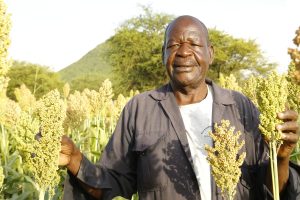For long, George Kila depended on maize farming, but he was increasingly getting the feeling that he was in an abusive relationship with the crop grown by most farmers in Busia County.
“The prices were terrible,” he says. With maize, like most other crops, farmers like Mr. Kila are dependent on a variety of factors when it comes to the market.
Perhaps the biggest factor is the availability of the produce in the market, and because most farmers will harvest at the same time, the dynamics of demand and supply mean that prices will be low hence low returns for the growers.
One day in 2016, his neighbour told him about a free training course on sorghum farming by the Cereal Growers Association.
Mr. Kila and his neighbours cautiously turned to growing sorghum and almost immediately began to see results.
Rose Matano recalls that her first profit from sorghum was KSh3,000 per kilogram. In comparison, a 90-kilogram bag of maize costs an average of KSh2,500.
For farmers, the main advantage was that sorghum would mature faster, which meant that they would reap the benefit faster, and that it was hardy, which made it possible to plant several times in a year as the crop doesn’t require much water.
They would soon become among the 47,000 farmers from across Kenya who supply East African Breweries Plc with sorghum, which is used to brew Senator Keg, mainly consumed by low-income drinkers.

EABL pays out more than KSh1 billion to sorghum farmers every year. The farmers are located in the Western region – Kisumu, Busia, Homa Bay and Migori counties – and in Meru and Tharaka Nithi counties. Under a programme dubbed Mtama ni Mali, the company has been working to progressively convert sorghum production from subsistence to sustainable commercial farming.
The strategy has been to encourage farmers to first of all grow sorghum as a food crop and sell the surplus to EABL.
Farmers contracted by the brewer are guaranteed that their produce will be bought and are supplied with farm inputs, such as fertilizer. The guaranteed market drives the whole value chain and the farmers’ confidence in their work is boosted by the reliability of the market.
For many farmers, who are smallholders, they hand over their sorghum to an aggregator for transportation to East Africa Maltings Limited (EAML), the company that handles the production of malt for EABL.
The aggregators work with the company to check the quality of the grain delivered before it is weighed and transported to Nairobi.
In 2018, EAML rolled out Farmforce, a mobile platform to track the contracted farmers.
Farmforce enables the company to keep track of the farmers and keeps the brewer appraised of the growing and harvesting of the raw material in real time.
“One of the main drivers of this value chain is traceability,” says Peter Mala, an officer at EAML.
Because Senator Keg has a tax remission on excise duty, the company is keen to demonstrate to its stakeholders that the sorghum used is grown in Kenya, and the only way to do that is by showing traceability.
The resurgence of sorghum as a cash crop has also inspired the development of other jobs, such as fabrication of threshers.
Patrick Githure, a metalworker in Meru, was inspired to create a thresher from seeing the challenges farmers were facing when threshing sorghum and shelling maize.
He developed a thresher that can be operated using a tractor as well as smaller ones that can be drawn by donkeys or oxen or hooked up to motorcycles.
“We used to thresh the sorghum using our hands, which is hard work and tedious. It takes about four or five days to thresh five bags of sorghum using your hands, but it takes 30 minutes when you use this machine,” Mr. Githure says with pride.
The impact has gone beyond the value chain of farmers, aggregators, transporters and others involved in the day-to-day production.
Timothy Njagi, a research fellow at Tegemeo Institute of Agricultural Policy and Development at Egerton University, says the entry of sorghum beer provided a stable market and revived interest in the crop by the scientific community.
“Researchers worked hard to double the number of improved varieties from 20 varieties in 2012 to 40 varieties in 2017,” he wrote in an opinion piece.
The stability of the market prompted farmers to increase their production, with some attaining up to 3.3 tons per hectare where the average yield before the establishment of sorghum brewing was 0.7 tons per hectare.
Despite the gains made in sorghum farming, it has not been without challenges for farmers.











